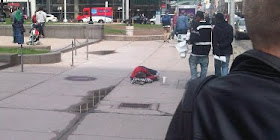Saturday, May 14, 2011
Sidewalk sleeping in Toronto
I'm with a Jeckel-and-Hyde Toronto this week. Like many successful cities, in some places there are vibrant and hip streets that absolutely fizzle with energy. In others, the homeless and indigent remind us nowhere is perfect.
Homelessness shows up in my SafeGrowth blogs on Vancouver, Seattle, and Houston.
I've also posted local solutions to homelessness in Portland and Colorado.
Walking downtown Toronto this week I saw more absolute homelessness than I've seen in a long time in this city.
In 1998 mayors across Canada declared homelessness a national disaster. Since then it hasn't improved. In many other countries, like the US, it is even worse.
In 2008 the University of Ottawa's Institute for the Prevention of Crime published a study called Homelessness, Victimization and Crime: Knowledge and Recommendations - a rather sterile title that seems to understate the tragic drama of an ignored person asleep on a sidewalk grate.
Luckily the report thoroughly lays out the dimensions of homelessness for Canada and urban places everywhere.
It reveals how homeless people are more likely to become involved in, and victims of, crime (mostly minor crime like public disorder). And while many homeless are incarcerated, a high proportion suffer from mental disorders and addictions rarely treated in the prison system.
The report offers up solutions like housing, shelters, social assistance, mental health treatment, and addiction programs. It offers controversial solutions like repealing laws that prohibit children with behavioral problems from attending mainstream schools. (It's those same kids who end up on the street.)
Sadly, as a walk in downtown Toronto and most other large urban cities confirms, four years after their report too many downtown streets are still the home of sidewalk sleepers.
Solutions on the page do nothing for tragedy on the stage. We need to do more.
Read their report HERE.
[NOTE: SafeGrowth's host site, Google's Blogger, has been offline this week for repairs]
2 comments:
Please add comments to SafeGrowth. I will post everyone except posts with abusive, off-topic, or offensive language; any discriminatory, racist, sexist or homophopic slurs; thread spamming; or ad hominem attacks.
If your comment does not appear in a day due to blogspot problems send it to safegrowth.office@gmail.com and we'll post direct.

 ...ignored in Toronto
...ignored in Toronto
Greg,
ReplyDeleteFirst, I hope that I am wrong about what I think is meant by "laws that prohibit children with behavioral problems from attending mainstream schools." My wife has been teaching cildren with behavioral problems in mainstreem schools for over 20 years here in the States. Are you saying that this is not permitted in Toronto schools? I would find that incomprehensible!
Second, have you read this by Malcom Gladwell(http://www.gladwell.com/2006/2006_02_13_a_murray.html) or any of the research into homelessness by Dennis Culhane? My initial thought is that Culhane would find the same things in Toronto and Colorado Springs as he found in Philadelphia and New York. Because of the widespread nature of power-law theory(Pareto Pinciple, 80/20 rule, or whatever you want to call it), I would be very surprised if the findings were different.
Yes Tim, I'm afraid you are not wrong about the Toronto school situation. That crime prevention report linked in the blog describes the Safe Streets Act in Ontario and the Safe Schools Act which apparently excludes troubled kids out of the regular school system. I wonder where the education reformers were when that happened?
ReplyDeleteI did look at the Malcolm Gladwell link. Thanks for that. He is a star when it comes to finding these cool research studies. And he's from Ontario as well!